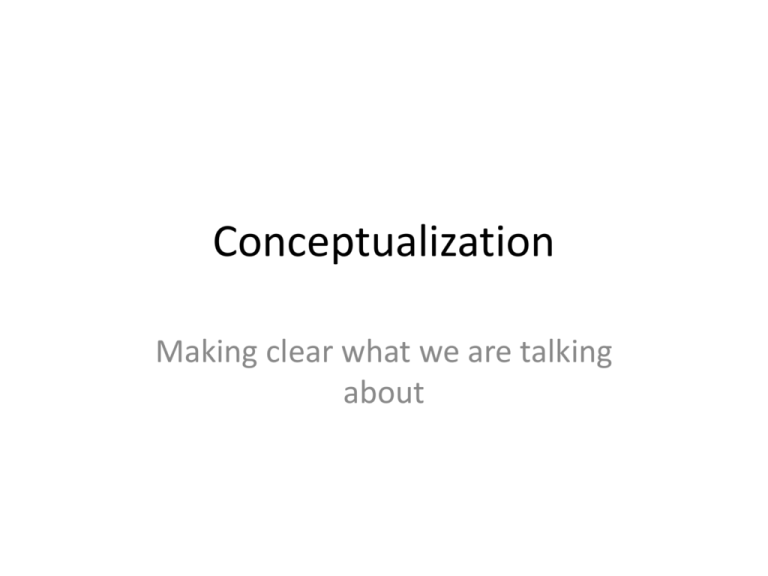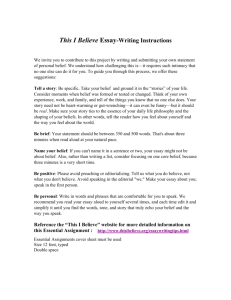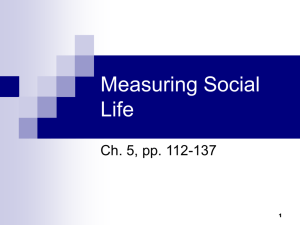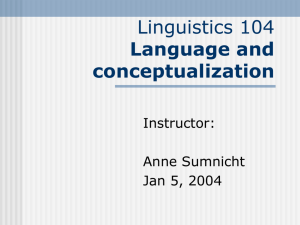Conceptualization
advertisement

Conceptualization Making clear what we are talking about A problem • In informal conversation, we often have a different understanding of the words we use – You and I may not really imagine the same thing when we talk about dogs and cats – It’s even more likely when we consider very abstract ideas like “honor” or “love” • The same is true of scholars studying various ideas Theory • Theory is dependent upon concepts, so careful definition of concepts is a critical part of theory development • Though we’ll tend to look at concepts one at a time it is necessary to take all the concepts in a theory into account simultaneously when “conceptualizing” Conceptualization • Conceptualization is the first step in explication • Conceptualization refers to the careful analysis of general ideas known as concepts – An intellectual process • Conceptualization takes us from the realm of vague, ambiguous ‘concepts’ to clearer, more distinct ‘constructs’ – Constructs are sufficiently concrete that researchers can develop measures of them Don’t get confused • What I am defining as a ‘construct’ is often called a ‘conceptual definition’ by others – The terms are often mixed up by different people • This is a case of the very problem noted above • Constructs help readers understand what we mean when using a given term – Otherwise, the reader may have a very different perception of what the concept means than we (as authors) do • • • • Presence Violence Enjoyment Age Conceptualizing • A number of methods can be used to refine concepts to where we can develop meaningful tests/measures of them • Meaning analysis • Inclusion analysis • Exclusion analysis • Theoretical necessity Meaning analysis • First, we review scholars’ definitions of the terms – Evaluate agreements and disagreements – Review the relative success of different uses – Evaluate dimensions within scales/measures for multiple components • We may review popular use of the terms – Webster’s definition – Roget’s thesaurus – Sticking close to common use of terms makes it easier to translate our work into something people can understand Meaning analysis • Look for sub-concepts • Watch for multiple concepts based on the same term – That is, a single word may stand for very different ideas • There may be scholars using different terms to describe the same idea we are interested in – Find these terms and review research carried out using them Example: Self-Efficacy • Self-efficacy has been defined in a variety of ways: as the belief that one is capable of performing in a certain manner to attain certain goals,[1] as a person’s belief about their capabilities to produce designated levels of performance that exercise influence over events that affect their lives.[2] It is a belief that one has the capabilities to execute the courses of actions required to manage prospective situations. It has been described in other ways as the concept has evolved in the literature and in society: as the sense of belief that one’s actions have an effect on the environment [3]; as a person’s judgment of his or her capabilities based on mastery criteria; a sense of a person’s competence within a specific framework, focusing on the person’s assessment of their abilities to perform specific tasks in relation to goals and standards rather than in comparison with others’ capabilities. Additionally, it builds on personal past experiences of mastery.[4 – Wikipedia • Subconcepts – Belief in personal ability to perform an act – Belief that performing the act will have the desired outcome Inclusion analysis • We think of actual events or objects or behaviors we would want to count as an example of the concept • When we apply our conceptual definition to the real-world example, does the example fall under the definition? – If not, rewrite the definition Example: Videogame addiction • Playing for 48 hours straight without eating • Playing every day • Giving up personal relationships to maintain online gaming Exclusion analysis • Are real-world behaviors, etc. that we feel should not be considered examples of the concept excluded under the definition? – Usually this means checking to see that similar but distinct examples do not get scored as examples of the concept under study – If not, rewrite the definition Example: Videogame addiction • Setting aside an hour every day to play • Becoming so absorbed in the game you lose track of time • Buying the newest version of your favorite games as soon as they come out Theoretical necessity • When we look at a concept within the context of a theory, the meaning of the concept may change • What is required of the concept for it to fit within the theory under study? – Adjust the conceptual definition to meet the requirements for the research Example: TV Violence • Cultivation theory – Inclusion of natural disaster – Intent unnecessary • Exposure-aggression theories – Exclusion of natural disaster – Intent necessary? Reconceptualization • Continual review of conceptual definitions should occur as a result of new research – Your own results should be taken into account when preparing for new research – The conceptualizations other researchers use, and their results should be taken into account in future research • Continuing refinement of concepts is part of scientific progress Reconceptualization • Occasionally, a major theoretical review is necessary • Cohen’s review of identification is an example – Multiple, conflicting conceptual definitions develop – Careful analysis is needed to explain how they developed, why they have differing and often contradictory features, and when and how the varying definitions seem to be more or less effective Example: Framing • Vastly varied and often incompatible definitions – Mass confusion in framing research and theory • Reese’s attempt to provide a definition to the field – Failed to be widely adopted – In a number of cases, the definition was cited but inappropriately applied to research









